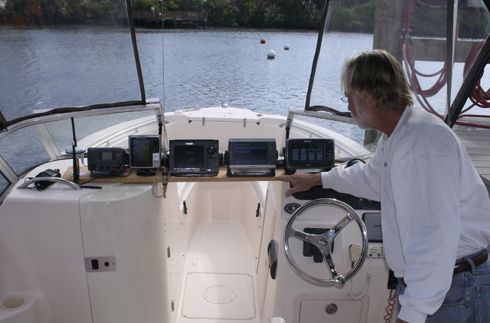
Practical Sailor contributor and marine electronics blogger Bill Bishop and I spent the latter part of last week testing two different types of man-overboard alarms. These are electronic devices that not only alert you when someone has gone overboard, but also use a built-in GPS to track the person in the water and transmit his position so that he can be located. PS looked at several similar devices back in May 2008 and April 2011.
The first product, the Mobilarm V100, couples with the boats DSC-equipped VHF radio. It broadcasts a loud distress signal on the VHF when activated, and then, as soon as a GPS fix available (between 30 seconds and a minute and a half in our tests), transmits the devices position via the DSC VHF. In the United States, this is a closed-loop alert between the device and the mothership. (Other profiles are available for different global regions.)
The second product was the Kannad SafeLink R10 SRS. Equipped with a built-in GPS receiver, it sends a structured alert message, GPS position data, and a special identity code to all AIS receivers within about four miles. The position data is updated every 60 seconds. During our test, the time between activating the device and receiving the signal varied between one and four minutes.
About an hour into our project, cold and wet after hurling myself repeatedly into the water to simulate falling overboard, my appreciation soared for a dead-simple harness and tether arrangement.
Bill and I are still sorting through the results of the multiple tests, so its too early to report on the specifics. (The full report should be wrapped up for the March or April issue.) In general, however, I would advise anyone considering these types of devices to carefully research product compatibility and to make sure they have the latest software upgrades to their multifunction displays (MFDs). The compatibility between the electronic chart display (ECDIS) used by onboard chartplotters or MFDs, which are supposed to display the MOB devices location and type of alert, is just one of the issues that still needs to be ironed out.
To track the SafeLink R10 signals, we connected three different displays-the Simrad NSS7, the Raymarine e7D, and the Garmin 740s-to a Digital Yacht AIS ANT200 antenna. Each of the multifunction devices responded differently to the signals. One of them, the NSS7, did not receive any signal from the SafeLink, a problem that Simrad is investigating and hopes to resolve soon with a software change. (The NSS7 fared well in our recent head-to-head test against the Raymarine e7D.)
Compatibility between the transmitting device and the receiver was not a problem with the V100, which must be programmed with the same maritime mobile service identity number (MMSI) as the ships DSC VHF radio. The MMSI programming was carried out at the Mobilarm factory prior to shipment. This was clearly the quickest device, instantaneously sending a loud audible alert when manually activated, but the water activation feature was inconsistent, something we are also still investigating.
Beyond the electronic challenges, we found more basic problems, such as: Where do we attach these devices? On the PFD? Many older harnesses are not designed with these types of devices in mind. Both units have antennas that must be kept above the water in order to transmit effectively. We paired them with a variety of Type III and inflatable PFD/harnesses, and it was interesting to see what happened when we attached them to patches designated for securing a strobe light, a Personal Locator Beacon (PLB), or an electronic man-overboard alert device like the ones we were testing.
While the shoulder patch on one of our inflatable PFD-harnesses (a West Marine 4000 Offshore series) looked liked a perfect place to put a strobe or PLB, as soon as the harness was inflated and the “victim” was in the water, the flap to which the device was secured-now opened to reveal the inflation bladders-was pinned underneath the swimmer’s shoulder blade, requiring some complicated contortions to retrieve and activate the MOB alerting device. In calm water, this added about 30 seconds to the time it took to activate the alert.

The Type III life jackets, on the other hand, offered several attachment options that worked better. We tried a variety of Type III jackets designed for racing, near coastal sailing, and other active sports, made by Gill, Stohlquist, and MTI Adventurewear. All of them had zipper pockets, and the Stohlquist and MTI jackets also had pouches and patches for lashing a PLB or MOB device. The Stohlquist and MTI designs are relatively new designs aimed at paddlesports and perfect for dinghy sailors. Im not sure Id prefer them to an inflatable harness/PFD for everyday use on a cruising boat (especially in the Florida summer), but I was impressed with the amount of flotation and freedom of movement they offered.
The inflatable PFD/harnesses theoretically provided more flotation, but the way the bladders tightend around the neck area made it much less comfortable in the water, and the added buoyancy didnt seem to translate into better flotation compared to the Type IIIs. As several recent safety studies have shown, adding a crotch strap to these inflatable harnesses can go a long way toward keeping ones head above the water.
Stay tuned for updates on both of these product categories in upcoming issues of Practical Sailor.




































